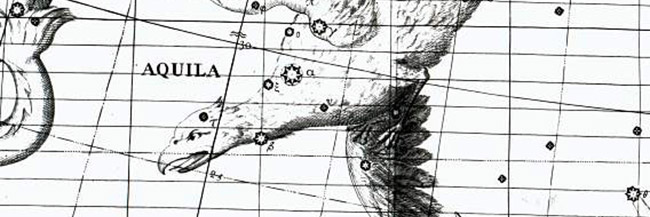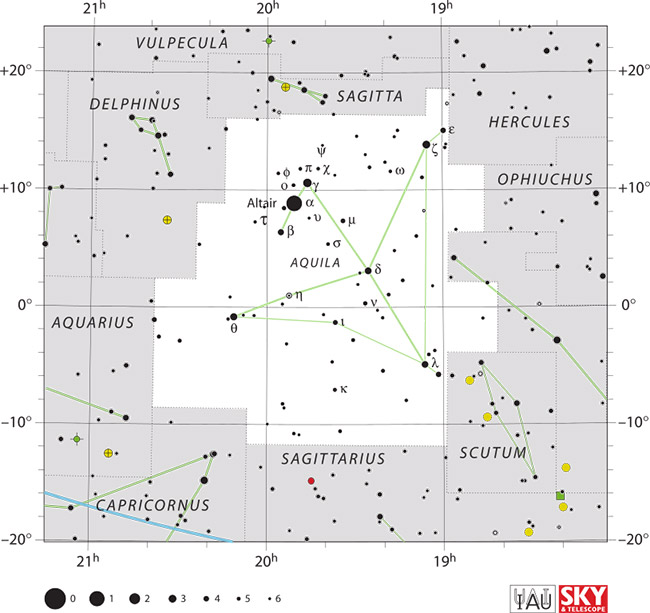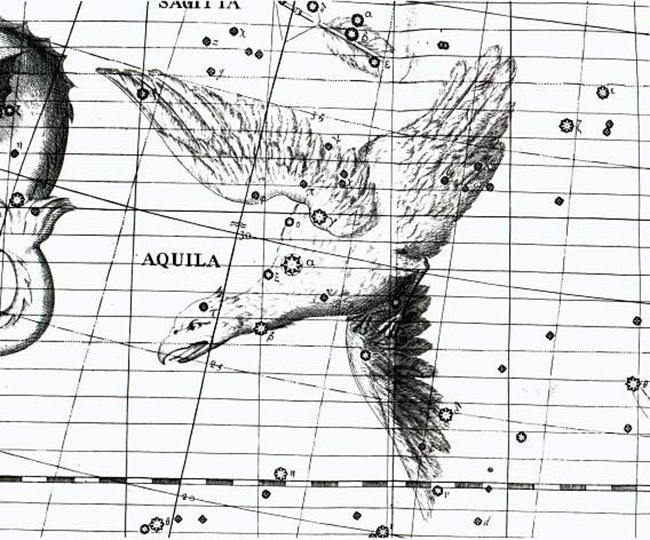Aquila – Constellation Facts

Aquila is a loose triangular-shaped constellation covering 652 square degrees in the fourth quadrant of the Northern hemisphere (near the celestial equator). It can be viewed at latitudes between +90° and -75°. Aquila represents the eagle of the Roman god, Jupiter and, in fact, gets its name from the Latin word meaning “eagle.”
Constellation Characteristics
Aquila is the 22nd biggest constellation and is neighbors with the constellations of Aquarius, Capricornus, Delphinus, Hercules, Ophiuchus, Sagitta, Sagittarius, Scutum and Serpens Cauda. In addition, Aquila has seven stars with known planets, as well as two meteor showers (the June Aquilids and the Epsilon Aquilids).

IAU and Sky & Telescope magazine (Roger Sinnott & Rick Fienberg), CC BY 3.0, via Wikimedia Commons
By IAU and Sky & Telescope magazine (Roger Sinnott & Rick Fienberg) CC BY 3.0, via Wikimedia CommonsPlanetary Systems
Although Aquila does not have any Messiers, it does contain four notable deep sky objects. Check them out:
- Phantom Streak Nebula (NGC 6741): even though this object is catalogued as a nebula, technically there were no planets responsible in the making of NGC 6741. This wonder is located about 7,000 light-years away and was first discovered by an American Astronomer (Edward Charles Pickering) in 1882.
- NGC 6709: appearing as a loose triangular-shape, this open star cluster is situated five degrees Southwest of Zeta Aquilae.
- NGC 6755: this open star cluster is located 4.5 degrees West of Delta Aquilae and has two bright stars that shine at a 12th and 13th magnitude.
- B143-4: located 1.5 degrees West of Gamma Aquilae, this dark nebula spans more than a degree in size.
Main Stars
The constellation Aquila contains six significant stars, but it also has four lesser (yet notable) stars making up its configuration.
- Altair (Alpha Aquilae) is the brightest star in Aquila (which will be discussed later in detail).
- Alshain (Beta Aquilae) is the seventh brightest star in Aquila. It shines 44.7 light-years away and is catalogued as a class G subgiant. It got its name from the Perso-Arabic word, aš-šāhīn, which means “the (peregrine) falcon.”
- Tarazed (Gamma Aquilae) is a class K (spectral class K3) bright giant that got its name from the Persian phrase šāhin tarāzu, meaning “the beam of the scale.” This star is around 100 million years-old and is also known as a source of X-rays.
- Deneb el Okab (Epsilon Aquilae) this triple star system is also known as, Deneb el Okab, an Arabic phrase (ðanab al-cuqāb) meaning “the tail of the eagle.” The brightest aspect of this star is a barium star known as a K-type giant.
- Deneb el Okab (Zeta Aquilae) is about 83.2 light-years in distance and is another triple star. The brightest component shines with a 2.99 magnitude and is considered an A-type main sequence dwarf.
- Bezek (Eta Aquilae) is 3,000 times brighter than the Sun and is, in fact, one of the easiest to spot in the night sky. Its name is derived from the Hebrew word (bazak) which means “lightning.”
- Tseen Foo (Theta Aquilae) is noteworthy as it is known as the “Celestial Drumstick” in Chinese – Mandarin word, tianfu, means “drumstick” or “heavenly rafters.”
- Al Thalimain (Iota Aquilae) lies about 307 light-years away and is a blue-white B-type star. Its name means “the two ostriches” which it shares with Lambda Aquilae.
- Al Thalimain (Lambda Aquilae) is a blue-white B-type main sequence dwarf. In 1973 NASA launched the probe, Pioneer 11, that is suppose to be enroute to this star. It is estimated to take around four million years to reach this celestial body; however, since the power source is too weak there has been no data transmitted since 1995.
- 15 Aquilae is about 320 light-years away and can be seen through a small telescope.

Aquila swooping across the pages of Flamsteed’s Atlas Coelestis (1729)
Most Shining Star
Out of all the stars that make up the Aquila constellation, none shine brighter than Altair or Alpha Aquilae. It is the 12th brightest star in the sky, shining with a visual magnitude of 0.77. It is a A-type main sequence star that sits about 16.8 light-years away and is 1.8 times the mass of our Sun. Altair gets its name from the Arabic phrase, an-nasr at-ta’ir, which means “the flying eagle.”
Mythology & History
Aquila is steeped in mythology. In the Greek legends, this constellation represented the eagle that carried Zeus’ thunderbolts. It was also the eagle used to snatch away Ganymede (the youth Zeus desired and later stole to be a cup-bearer to the gods). Another myth has the eagle guarding the arrow of Eros – it hit Zeus, making him love-struck. Some mythology also speaks of Aphrodite disguised as an eagle in pursuit of Zeus. She then took on the form of a swan to chase Zeus to the shelter of his love interest, the goddess Nemesis. It is said that Zeus placed Aquila in the heavens to represent this occasion.
Aquila is a fascinating constellation, so the next time you are gazing into the night sky be sure to search out this intriguing figuration of stars.
